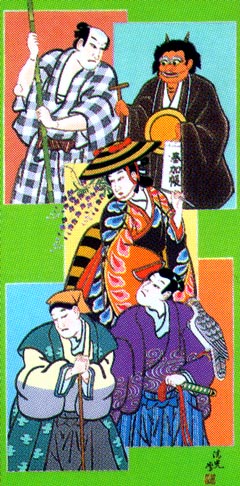| ÔTSUE DÔJÔJI |
| Play title | Ôtsue Dôjôji |
| Authors | Kawatake Mokuami (lyrics) Fujima Kanjûrô VI (choreography) |
| History |
The dance "Ôtsue Dojoji" is a parody of "Musume Dôjôji", skillfully bringing in the figures of several of the Ôtsu pictures, each performed by the same dancer in a series of quick changes of costumes. "Ôtsue Dojoji" is based on a text written by Kawatake Mokuami, but was evidently unperformed and unknown even among specialists, until it was discovered by chance through an old book store. In spite of its discovery and its established authorship, however, it remained unperformed for some time due to lack of a suitable performer to stage it. The occasion came in 1965 at Ôsaka's Nakaza, with Jitsukawa Enjaku III's first Ôsaka program following his name-taking ceremony. The original text by Mokuami was somewhat enlarged to add additional ôtsue characters besides the Wisteria Maiden and the Demon of the original, by the choreographer Fujima Kanjûrô VI [more details]. This dance was successfully staged in June 2000 at the Kabukiza, starring Living National Treasure Nakamura Ganjirô III in the five roles [more details]. It is now an important dance in Tôjûrô's repertoire. |
| Key words | Shosagoto Nagauta Tokiwazu Dôjôjimono Ôtsue Fuji Musume Ya-no-Ne Benkei |
| Summary |
The scene resembles that of the familiar "Musume Dôjôji", with a huge gong dominating the scene. This gong is to be newly installed with a ceremony that day. Instead of the usual white-robed acolytes, however, a group of karako, pig- tailed youths dressed in Chinese-style costumes, make their appearance. After a humorous session involving the karako and a hyôtan namazu, a caricature of a cat- fish, there is a rumble of drums, and the figure of Fuji Musume suddenly appears. Fuji Musume or Wisteria Maiden, is a reproduction of one of the Ôtsu pictures, and in this dance, replaces the shirabyôshi dancer of the original "Musume Dôjôji". Although there is a rule against allowing a woman into the precincts, the men are easily induced to waive this rule, in exchange for her performing a dance for them. But as the maiden is performing a series of dances, a falcon flies to the scene, frightening her so that she hides behind a pine tree. An instant later, the falcon handler (performed by the same actor as Fuji Musume) makes his appearance, chasing the bird. After a brief dance, he exits with his bird. Now a dog appears on the scene, followed by a blind masseur (this masseur is also played by the same actor). The dog and the masseur perform a humorous dance interlude, before they too exit. Now Fuji Musume reappears from behind a pine tree, and continues her pretty dance. But suddenly it begins to thunder, and she hides again behind the tree. A boatman appears and in spite of his usual boastful manner, shows himself to be afraid of the thunder. Fuji Musume reappears with fans to continue her dance again. But this time she is intent on cursing the temple gong. Mysterious clouds appear, and the maiden disappears under the fallen gong. Brawny Benkei comes hurrying to the scene, followed by spear-wielding lackeys. They see the fallen gong. Benkei orders the men to lift it, but as they lack the physical strength to do so, they ask Benkei to use the power of his incantations to achieve the purpose. Then they pull on the gong's rope and raise it. Inside it, they find the Demon (another figure from the Ôtsu pictures, again performed by the same actor), who comes out and engages them in a fight. At this point, the oshimodoshi or "one who pushes back", of the original "Musume Dôjôji", appears in the person of Ya-no-Ne no Gorô, a popular Kabuki hero. Instead of the huge bamboo pole carried by the usual oshimodoshi, Gorô carries his customary outsized arrow. The adversaries face each other fiercely. Then, in the usual climax as seen in "Musume Dôjôji", the demon climbs atop the gong to strike a dramatic and defiant pose with the lackeys arranging themselves in the shape of a coiling serpent around the gong, and with Gorô and Benkei also arranged in effective poses for the final tableau. |
 |
|
Ôtsue Dôjôji |
|
|
| Contact | Main | Top | Updates | Actors | Plays | Playwrights | Programs | Links | FAQ | Glossary | Chronology | Illustrations | Prints | Characters | Derivatives | Theaters | Coming soon | News |